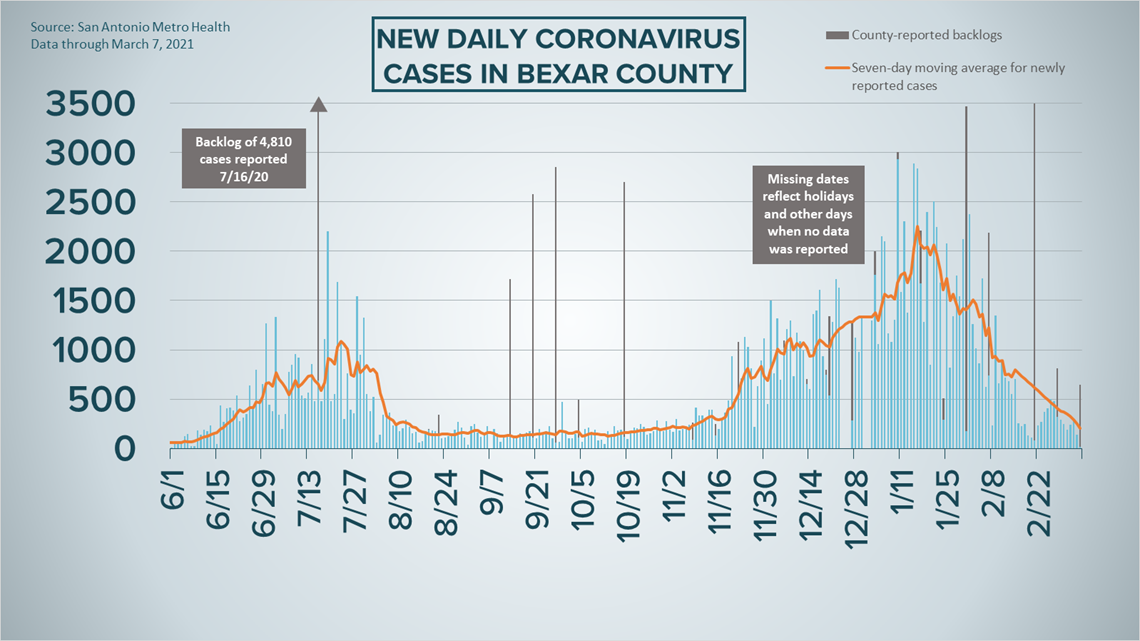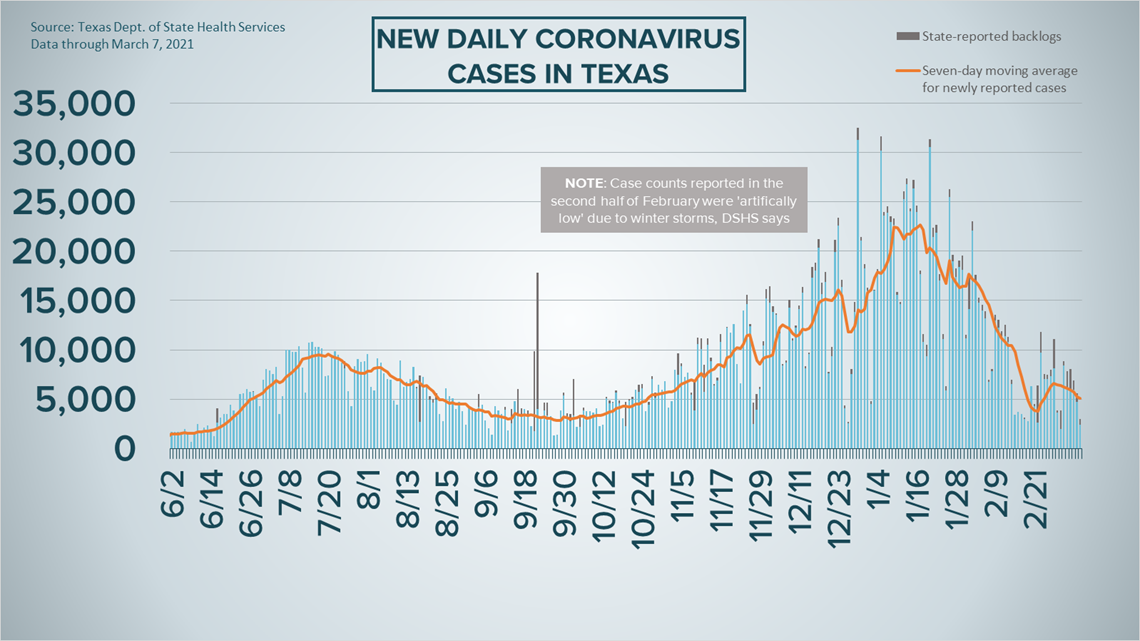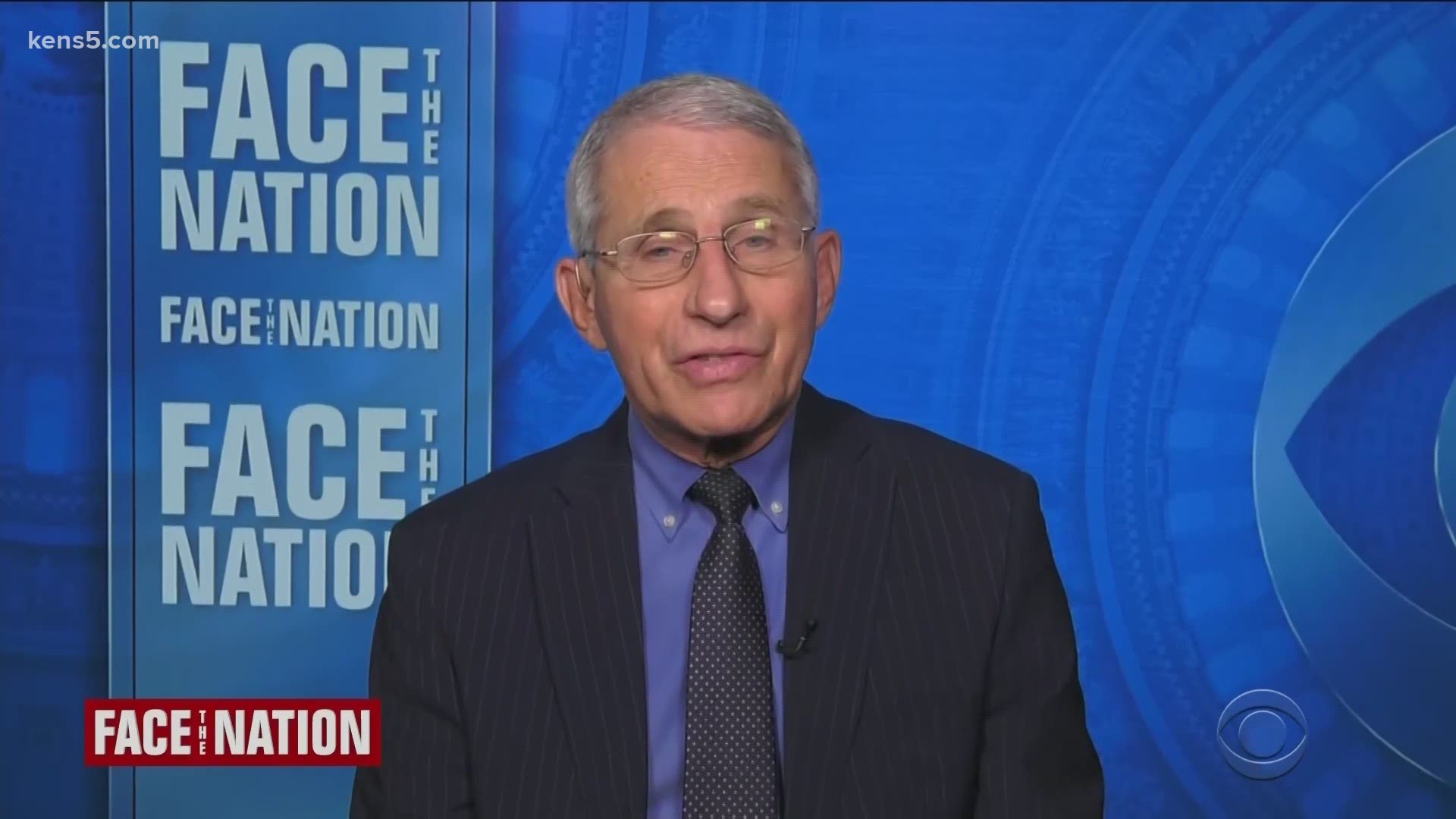SAN ANTONIO — We're tracking the latest numbers from the coronavirus pandemic in San Antonio and across Texas. Here are the latest numbers reported by Bexar and surrounding counties:
- Bexar County: On Sunday, 15 new cases were reported along with a backlog of 632, bringing the total number of cases to 197,921. Two new deaths were reported, and a backlog of 160 deaths between November and February brought the local death toll from virus complications to 2,847.
- Hays County: On Thursday, officials reported 23 new cases in the county and one additional COVID-related fatality. There is now a total of 16,458 lab-confirmed local cases, while the death toll increased to 225. Officials estimate 15,619 residents have recovered, while 614 are still ill with the virus.
- Comal County: Officials reported 22 new cases and eight backlogged cases on Friday, along with no additional virus-related deaths. As of Friday, 9,268 total COVID-19 cases have been reported, including 4,890 confirmed and 4,358 probable cases, while 294 county residents have died due to COVID-19 complications.
More county case information is available through the Texas Department of Health Services COVID-19 dashboard.
How Bexar County is trending
We've tracked how many coronavirus cases have been confirmed in Bexar County from the time officials began reporting cases in March 2020. The graphic below shows the number of cases since June and charts those daily case numbers along a 7-day moving average to provide a more accurate picture of the overall coronavirus case curve in our area and the direction we're trending amid the pandemic.
On Sunday, Metro Health updated its online coronavirus-tracking dashboards to reflect 15 new cases in Bexar County, along with a backlog of 632 older cases. That brings the local diagnosis total to 198,568 since the pandemic began. The new seven-day moving average is 201 new cases per day.


Meanwhile, two new deaths were reported by health authorities. A backlog of 160 deaths that occurred between November 9 and February 20 brought the local death toll to 2,847.
Hospitalizations decreased once again on Sunday, this time by 10 to an overall total of 291 COVID-19 patients receiving treatment at local facilities. The number of patients on ventilators (68) and in intensive care (123) both went down from Saturday as well.


Coronavirus in Texas
The total number of novel coronavirus cases in the state since the pandemic began grew by 2,933 on Sunday, according to the Texas Department of State Health Services. That total includes 1,805 new confirmed cases, 615 new probable cases, and a backlog of 533 cases. More details can be found on this page.
Sunday's figures bring the total number of Texans diagnosed with COVID-19 to more than 2.686 million.


Meanwhile, state health authorities reported an additional 84 deaths from coronavirus complications in Texas. In all, 44,451 Texans have died from COVID-19.
Texas hospitalizations saw another large drop of 200 on Sunday, decreasing to 4,721 COVID-19 patients receiving treatment for their symptoms across the state. Since the pandemic's high point of 14,218 hospitalizations on Jan. 12, the figure has fallen by 65%.
The state, meanwhile, estimates that about 2.502 million Texans have recovered, while 137,108 Texans remain ill with COVID-19.
The latest update from the Texas Education Agency showed that there have been at least 190,308 cumulative cases among staff and students on Texas public school campuses through Feb. 28. That number comprises 123,875 positive student cases and 66,433 staff cases. More information can be found here.
The TEA typically releases new data on school cases on Fridays.
Latest Coronavirus Headlines
- Signup for 10,000 first-dose coronavirus vaccine appointments at Alamodome to be made available Monday night
- WellMed closes COVID-19 vaccine reservation hotline until Monday
- Fauci: COVID-19 variant discovered in New York not widespread yet, but White House taking it 'very seriously'
- While the state has changed the mask order, here's what some restaurants plan to do
- Mask mandates and dining out can affect COVID spread, CDC study finds
- COVID-19 Vaccine Tracker: Fast facts and how to participate in Phase 1B distribution in San Antonio
Coronavirus symptoms
The symptoms of coronavirus can be similar to the flu or a bad cold. Symptoms include fever or chills, cough, shortness of breath or difficulty breathing, fatigue, muscle or body aches, headache, new loss of taste or smell sore throat, congestion or runny nose, nausea or vomiting, and diarrhea, according to the Centers for Disease Control.
Most healthy people will have mild symptoms. A study of more than 72,000 patients by the Centers for Disease Control in China showed 80 percent of the cases there were mild.
But infections can cause pneumonia, severe acute respiratory syndrome, kidney failure, and even death, according to the World Health Organization. Older people with underlying health conditions are most at risk.
Experts determined there was consistent evidence these conditions increase a person's risk, regardless of age:
- Chronic kidney disease
- COPD (chronic obstructive pulmonary disease)
- Obesity (BMI of 30 or higher)
- Immunocompromised state (weakened immune system) from solid organ transplant
- Serious heart conditions, such as heart failure, coronary artery disease, or cardiomyopathies
- Sickle cell disease
- Type 2 diabetes
The CDC believes symptoms may appear anywhere from two to 14 days after being exposed.
Human coronaviruses are usually spread...
- Between people who are in close contact with one another (within about 6 feet).
- Through respiratory droplets produced when an infected person coughs, sneezes or talks. These droplets can land in the mouths or noses of people who are nearby or possibly be inhaled into the lungs.
- Some recent studies have suggested that COVID-19 may be spread by people who are not showing symptoms.
Help stop the spread of coronavirus
- Stay home when you are sick.
- Eat and sleep separately from your family members
- Use different utensils and dishes
- Cover your cough or sneeze with your arm, not your hand.
- If you use a tissue, throw it in the trash.
Find a Testing Location
City officials recommend getting a COVID-19 test if you experience fever or chills, cough, shortness of breath or difficulty breathing, fatigue, muscle or body aches, headache, new loss of taste or smell, sore throat, congestion or runny nose, nausea or vomiting, or diarrhea.
A self-screening tool is available to see if you need a test.
Here's a Testing Sites Locator to help you find the testing location closest to you in San Antonio.

